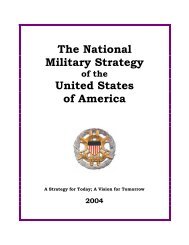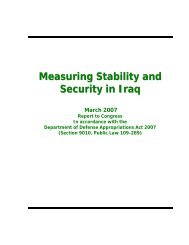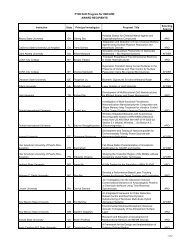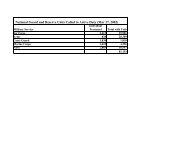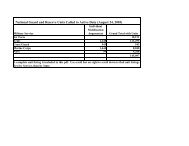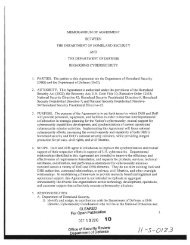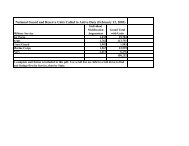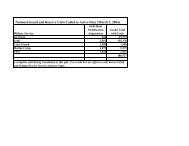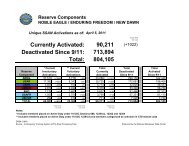Report - United States Department of Defense
Report - United States Department of Defense
Report - United States Department of Defense
Create successful ePaper yourself
Turn your PDF publications into a flip-book with our unique Google optimized e-Paper software.
UNCLASSIFIED<br />
SECTION 4– RECONSTRUCTION AND DEVELOPMENT<br />
4.1: ECONOMIC GROWTH AND DEVELOPMENT 37<br />
According to the World Bank, real GDP growth for Afghanistan this year is projected to be<br />
robust, at 10 to 11 percent, but is expected to drop in the coming years, from the decade average<br />
<strong>of</strong> nine percent annually to more a more modest range <strong>of</strong> five to seven percent a year. Economic<br />
growth prospects will depend on a number <strong>of</strong> factors, including: the security environment,<br />
improvements in the business climate, the performance <strong>of</strong> the agriculture and mining sectors, and<br />
the trajectory <strong>of</strong> international assistance. The government has continued to effectively manage<br />
Core inflation and keep it within the IMF targets. Based on the Kabul Consumer Price Index<br />
(CPI), the annualized inflation rate for FY2012 <strong>of</strong> 6.6 percent was well below the FY2011/12<br />
rate <strong>of</strong> 13.6 percent. During the same period, the annualized inflation rate for food and non-food<br />
were 2.9 percent and 9.2 percent respectively.<br />
It has been estimated that two to three basis points <strong>of</strong> growth are attributed to the presence <strong>of</strong> the<br />
coalition forces in Afghanistan. However, one major driver <strong>of</strong> the GDP growth rate appears to<br />
be the very high level <strong>of</strong> international funding that is transferred into the Afghan economy for<br />
services such as transportation and logistics and when it covers Afghan civil service or other<br />
labor costs, such as ANSF costs. The Afghan economy’s growth rate would likely be adversely<br />
affected if a reduction in donor funding was to occur precipitously to any significant degree.<br />
These macro factors place increased pressure on the Afghan government to identify alternative<br />
areas <strong>of</strong> potential growth and to comply with the benchmarks agreed to at the Tokyo Conference<br />
to ensure continued funding commitments. Afghanistan must achieve a series <strong>of</strong> results within<br />
specific, pre-agreed priority areas in order to maintain the flow <strong>of</strong> the four-year, $16B in<br />
commitments through 2015 made by the international donor community (donors) for<br />
development, approximately $4B each year.<br />
Afghanistan remains a very poor country with a growing youth population and increased public<br />
expectations government delivery <strong>of</strong> services, putting pressure on the government to provide a<br />
suitable enabling business environment to gain the confidence <strong>of</strong> Afghans and investors to<br />
develop a tax base to foster additional revenues. 52 percent <strong>of</strong> development budget, or $1.04B <strong>of</strong><br />
the $2B in FY2012 funds carried on the government’s books, is executed. The FY2013 national<br />
budget is $6.8B, with the development approximately $3.2B (adding $2.2B to the development<br />
portion <strong>of</strong> the national budget.) This will pose a significant challenge in planning, prioritization,<br />
contracting, program management, and overall financial management. Progress has been made<br />
in many areas; however, service delivery has not yet achieved a level that will bring about a<br />
consensus belief in the government and financial sustainability. Comprehensive progress is not<br />
likely for a number <strong>of</strong> years. Donors have collectively provided funding and technical expertise<br />
in significant areas, advancing Afghanistan’s overall level <strong>of</strong> capacity. Programs and projects<br />
undertaken in several fundamental areas include: building governmental capacity; jump-starting<br />
and growing the economic base; developing infrastructure; building a self-sustaining security<br />
37 Much <strong>of</strong> the data derived for this section is from the World Bank. They assert “...collecting reliable data on Afghanistan is extremely difficult.<br />
Moreover, much <strong>of</strong> the information that is available is subject to large margins <strong>of</strong> uncertainty, as well as <strong>of</strong>ten problems <strong>of</strong> incompleteness,<br />
incomparability, etc.” World Bank, “Afghanistan in Transition: Looking Beyond 2014,” May 2012.<br />
152



